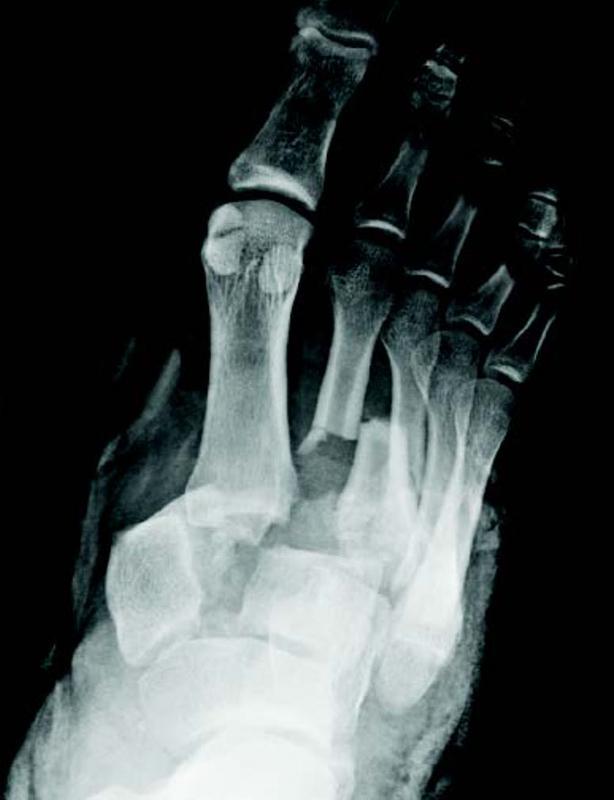Erick's Story
OUTLET
 Erick presented with contaminated open type 3B fractures and dislocations of the midfoot. The dorsal skin and soft tissue of the foot were destroyed. The radiograph of the foot shows displaced fractures of the 2nd and 3rd mid metatarsals with dislocations of all 3 cuneiforms and all 5 tarsometatarsal joints.
Erick presented with contaminated open type 3B fractures and dislocations of the midfoot. The dorsal skin and soft tissue of the foot were destroyed. The radiograph of the foot shows displaced fractures of the 2nd and 3rd mid metatarsals with dislocations of all 3 cuneiforms and all 5 tarsometatarsal joints.
Remembering that night, Erick marvels over all the dominos that had to line up for things to happen the way they did. He planned to head out of town the next morning. The fuel coil on his father's car conked out. He was one tool short of what he needed to fix it. He needed to get over to a friend's place to borrow what he needed. The weather was gorgeous. Why not take the motorcycle?
And so the 26-year-old project manager with a manufacturing firm found himself riding down a two-lane back road in Wellington, OH on the evening of August 13, 2015. He remembers his attention wandered toward a list of things he wanted to get done before his trip. He didn't see that the truck ahead had come to a dead stop until too late.
His first instinct was to veer into the other lane and loop around the truck. But he couldn't see whether there was any oncoming traffic, so he instead dropped his bike into a slide that then sent his body tumbling and bouncing its way into a roadside ditch.
"I was able to sit right up," Erick recalls. "My adrenalin was going, and I didn't really feel the pain. But when I tried to stand up, that didn't work out so well. I remember thinking, 'Did I break my femur?'"
An onlooker dialed 911. A Life Flight helicopter from the trauma center at MetroHealth Medical Center in Cleveland arrived soon thereafter.
Doctors at MetroHealth told Erick that the broken femur in his left leg was actually the lesser of his two biggest problems. They were worried that he might lose his right foot, where nearly every bone from the ankle on down was dislocated or fractured.
This decision point—should we amputate?—was the focal point of the OUTLET study. Nearly 400 patients signed on at 35 trauma centers around the country. The project compared the physical functioning and quality of life outcomes for patients who underwent amputation after suffering severe foot and ankle trauma with those of patients whose foot was salvaged.
Erick decided to have his foot salvaged. He endured nine surgeries in the month after his accident, with physicians moving step by step from stabilizing his situation to reconstruction and plastic surgery. The most painful operation, he says, involved taking muscle from his abdomen and putting it into his foot—the arteries and veins in that muscle tissue are now helping him maintain a healthy flow of blood.
Erick says deciding to participate in these studies was easy for two reasons. First, he feels grateful toward the surgeons who had worked so hard on his behalf, and secondly, he hopes his experience might be of some benefit to future patients.
"If just one person is helped, that will make it worth it to me," he says.
Heather Vallier, an orthopaedic trauma surgeon at MetroHealth, says such thinking is typical of the study participants she works with. "When we ask about participating, a lot of patients approach it from this generous angle of ‘paying it forward,'" she explains. "They feel like this is an opportunity to take an awful event in their lives and give it a positive aspect." She added that many also see their participation as a way to help the men and women who have been injured in service to the country.
Erick is happy with the steady progress he has been making up to this point. He received the all clear to start putting weight on the broken foot just before Thanksgiving 2015.
"That was such a great feeling," he says. "Everyone in my family was so supportive during this, and being up and around a little bit with them at the holiday—it was like I was saying, ‘Look everybody, I'm going to be OK.'"
With Erick now back at his old job at MTD Products, Vallier counts him as "one of the lucky ones" among her patients. Many patients with severe extremity trauma are unable to return to work, especially in physically demanding positions.
"The challenges that these patients face when it comes to simply getting out and making a living can be quite daunting," says METRC co-chair Andrew N. Pollak. "The latest data I've seen show that half of them are never able to get back to work, in any capacity. Numbers like that really demonstrate the urgency of the work the Consortium is doing."